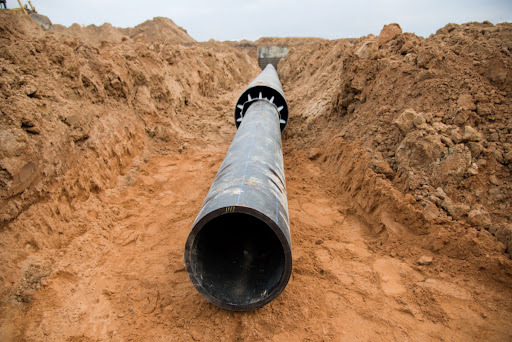Old, damaged, or cracked sewer lines can cause many problems for your property. If you’re in need of a repair, you might be wondering which repair route you should take. Many homeowners and plumbers rave about the benefits of trenchless services, such as pipe relining, while traditional trench repairs have been a go-to solution for many years. It’s easy to feel stuck when weighing the benefits of relining vs. trenching.
Whether your sewer line is just starting to fail or has been causing trouble for a while, it’s important to schedule a repair promptly. The last thing you want to deal with is a costly water bill or smelly lawn. Let’s dive into the pros and cons of trenchless vs. trenching sewer repairs without wasting another minute.
What Is Trenching?
Before discussing the advantages and disadvantages of trenchless vs. trenching sewer repairs, it’s crucial to understand how these two methods work. We’ll start with the traditional trenching method.
When you need a trenching service, a plumber will dig a trench on your property to fully access the sewer line. The pipe will be completely excavated and exposed, allowing the technician to perform the necessary service in the open air. This method can be used for repairs and replacements.
Pros
Trench sewer repairs, which are sometimes referred to as “open trench” repairs, could be a good solution when homeowners only need to repair a small, contained portion of the sewer pipes.
Traditional trench services could be for you if you’re looking for the most dependable method of repairing a sewer line. Since the technicians have complete access to the pipe and can see everything clearly, there is less chance they’ll accidentally damage the surrounding utilities.
Cons
When discussing the pros and cons of relining vs. trenching, it’s important to mention the drawbacks these methods can have. All-in-all, digging a trench on your property is no small feat. When the service has been completed, you’ll likely be left with an unkempt lawn and landscape.
What does this mean? When it comes down to it, you’ll probably need to reconstruct your outdoor areas so that they look clean and presentable like before. This could involve planting new grass or investing in fresh flowers. This might be an additional expense you’ll want to factor into the overall cost of the service.
It’s also worth noting that the time frame of the repair might be longer than you expect it to be. Depending on the extent of the project, the repair could take a few days or longer. This can be especially challenging if you need to make different living arrangements. Some open-trench repairs may require you to live off-premises for the duration of the job.
What Is Pipe Relining?
Since we’re discussing trenchless vs. trenching sewer repair, it’s important to know both options’ ins and outs. To put it briefly, pipe relining is a trenchless method that involves inserting a new epoxy resin-covered liner into the damaged pipe. Once installed, the liner will expand and cover the damaged pipe.
This method, sometimes referred to as “cured-in-place piping,” creates a hard casing inside the pipe that can seal leaks and prevent tree root intrusions from occurring.
Of course, pipe relining shouldn’t be confused with “pipe bursting.” During a pipe bursting service, which is another form of trenchless sewer line repair or replacement, a team of experts will pull a new pipe through the current pipe. The existing pipe is “burst” in the process, giving way to the new, durable pipe.
Although pipe lining is one of the most common trenchless sewer line repairs, there are various advantages and disadvantages worth considering. Let’s take a look at them below.
Pros
Many plumbers in Tucson will recommend using trenchless technology during a sewer repair, and for good reason. If you’re looking for a durable solution, pipe relining could be appropriate. This cured-in-place piping can last up to 50 years.
There is also a significant difference when it comes to the excavation involved with relining vs. trenching. While traditional trenchless repairs require a professional team to dig a large hole, pipe relining will only require you to dig a small access point on your property. This is excellent news since your lawn and landscaping will remain intact during the repair.
Cons
In some instances, trenchless sewer repairs might not be a viable option if the sewer line is extensively damaged or beyond repair. You won’t be able to select this option if you have a collapsed or burst pipe on your hands.
Another drawback could be that relining services sometimes cost more than their traditional excavation counterparts. Of course, there are many other factors to consider beyond upfront pricing. For example, trenchless pipe repairs tend to be quicker and are known for being non-invasive.
Is Pipe Relining Worth It?
When choosing between relining vs. trenching, it all comes down to your specific needs. For many homeowners, pipe relining is worth it because it doesn’t disrupt their property and provides a long-lasting solution to an otherwise troublesome problem. Of course, getting a second opinion is never a bad move. It’s always an excellent idea to consult a professional plumber to discuss your options before scheduling a service.
Contact Us for Your Sewer Line Services
There are many advantages and disadvantages to trenchless vs. trenching sewer repair. If you’re ready to schedule a service, don’t hesitate to reach out to Rite Way Heating, Cooling & Plumbing for help. Damaged pipes are a hassle, but our experts are here to provide you with a suitable solution.
Our plumbing experts offer dependable services, whether you need a sewer line repair or water heater replacement in Tucson, AZ. Contact us today to see what our team can do for you!

